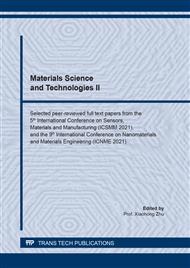[1]
A.E. Tekkaya and T. Altan: Sheet Metal Forming: Processes and Applications. Materials Park, Ohio: ASM International (2012).
Google Scholar
[2]
Information on https://www.plantengineering.com/articles/university-initiates-mass- manufacture-of-disposable-face-shields-for-covid-19-response/.
Google Scholar
[3]
W. Sanamthong and P. Chutima: Chipping size reduction on Ultra-Thin wafers and Narrow Saw-Streets for Wafer Sawing Process. Solid State Phenomena, Vol. 305 (2020), pp.154-162.
DOI: 10.4028/www.scientific.net/ssp.305.154
Google Scholar
[4]
R. B. Singh and P. Kumar: Application of DMAIC Methodology in Stamping Production Process. International. Research Journal of Engineering and Technology, Vol. 3 (2016), pp.2347-2349.
Google Scholar
[5]
S. Muangyai and P. Chutima: Defects Reduction in Spheroidal Graphite Iron Casting Process of a Jack Screw Manufacturer. Key Engineering Materials, Vol. 891 (2021), pp.174-182.
DOI: 10.4028/www.scientific.net/kem.891.174
Google Scholar
[6]
T. Sawatsuphaphon and P. Chutima: Contactless Chip Module Defect Reduction. Solid State Phenomena, Vol. 305 (2020), pp.59-64.
DOI: 10.4028/www.scientific.net/ssp.305.59
Google Scholar
[7]
Information on https://asq.org/quality-resources/flowchart.
Google Scholar
[8]
S. Crowe, K. Cresswell, A. Robertson, A. Avery and A. Sheikh: The case study approach. BMC Med Res Methodol (2011).
DOI: 10.1186/1471-2288-11-100
Google Scholar
[9]
M. Smętkowska and B. Mrugalska: Using Six Sigma DMAIC to improve the quality of the production process: a case study. Procedia-Social and Behavioral Sciences, Vol. 238 (2018), pp.590-596.
DOI: 10.1016/j.sbspro.2018.04.039
Google Scholar
[10]
J. Palrungsri and P. Chutima: Dip degreasing stage improvement in car body pretreatment process by Six Sigma. Key Engineering Materials, Vol. 981 (2021), pp.167-173.
DOI: 10.4028/www.scientific.net/kem.891.167
Google Scholar
[11]
W. Sirimongkol, P. Chutima and S. Nilpairach: Defect Reduction in Forming Process of Fired Clay Floor Tiles by Six Sigma Approach. Solid State Phenomena, Vol. 305 (2020), pp.147-153.
DOI: 10.4028/www.scientific.net/ssp.305.147
Google Scholar
[12]
J. A. Staff, S. Reynard and D. Mann: Pareto Charts: Plain & Simple, Oriel Inc (1995).
Google Scholar
[13]
S. Bojan, Z. Šarkočević, L. Dragan and M. Danijela: Application of the Pareto analysis in project management (2015).
Google Scholar
[14]
M. V. Stappen, L. M. Stals, M. Kerkhofs and C. Quaeyhaegens: State of the art for the industrial use of ceramic PVD coatings. Surface and Coatings Technology, Vol. 74 (1995), pp.629-633.
DOI: 10.1016/0257-8972(95)08296-4
Google Scholar
[15]
B. Navinšek, P. Panjan and I. Milošev: PVD coatings as an environmentally clean alternative to electroplating and electroless processes. Surface and Coatings Technology, Vol. 116 (1999), pp.476-487.
DOI: 10.1016/s0257-8972(99)00145-0
Google Scholar
[16]
M.A. Fairuz, M.J. NurulAdlina, A. I. Azmi, M.R.M. Hafiezal, and K.W. Leong: Investigation of Chip Formation and Tool Wear in Drilling Process Using Various Types of Vegetable-Oil Based Lubricants, Applied Mechanics and Materials, Vol. 799-800 (2015), pp.247-250.
DOI: 10.4028/www.scientific.net/amm.799-800.247
Google Scholar
[17]
S. M. Agrawal, K. and N. G. Patil: Experimental study of non-edible vegetable oil as a cutting fluid in machining of M2 Steel using MQL. Procedia Manufacturing, Vol. 20 (2018), pp.207-212.
DOI: 10.1016/j.promfg.2018.02.030
Google Scholar
[18]
A. Suhane, R. M. Sarviya, A. R. Siddiqui and H. K. Khaira: Optimization Of Wear Performance of Castor Oil Based Lubricant Using Taguchi Technique. Materials Today: Proceedings, Vol. 2, pp.2095-2104.
DOI: 10.1016/j.matpr.2017.02.055
Google Scholar
[19]
P. V. Krishna, R. R. Srikant and D. N. Rao: Experimental investigation on the performance of nanoboric acid suspensions in SAE-40 and coconut oil during turning of AISI 1040 steel. International Journal of machine tools and manufacture, Vol. 50 (2010), pp.911-916.
DOI: 10.1016/j.ijmachtools.2010.06.001
Google Scholar
[20]
U. Wiklund, J. Gunnars and S. Hogmark: Influence of residual stresses on fracture and delamination of thin hard coatings. Wear, Vol. 232 (1999), pp.262-269.
DOI: 10.1016/s0043-1648(99)00155-6
Google Scholar


